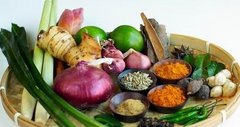 Ingredients:
Ingredients:
- 160g rice flour
- 20g lek tau hoon (green beans flour)
- 150ml water
For the syrup
- 150g castor sugar
- 300ml water
- 2-3 daun pandan (screwpine leaves), knotted
- 250ml coconut milk
- 1/4 tsp salt
- a few drops red colouring
Method:
Combine sugar, screwpine leaves and water in a saucepan. Bring to a boil to dissolve the sugar. Strain and set aside to cool.
Put rice flour and green bean flour into a large mixing bowl. Pour in water gradually and leave aside to soak for 45 minutes. Add coconut milk and salt to the rice flour mixture and mix well. Stir in syrup. Strain the batter to ensure it is free from lumps.
Divide the batter into two. Leave half a portions white and add the red colouring to the other half.
Places a greased 20cm tray in the steamer and heat up for 5 minutes. Pour half cup of the white batter on to the heated tray. Cover and steam over medium heat for 5 minutes or until set.
Pour half cup of the pink batter over the white layer and steam covered for 5 minutes or until set. Repeat the procedure, alternating white and pink batter until all the batter is used up.
To the very last layer, add a little more red colour to make it a deeper shade of pink.
After the final layer is set, steam the kuih for a further 15 minutes. Halfway through open the lid to release the stem, then cover again until the end of the steaming process.
Cool the kuih throughly before cutting into small diamond-shaped pieces.







































